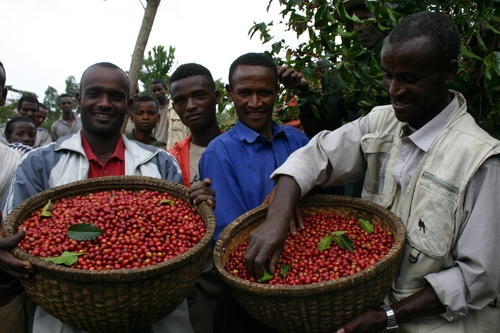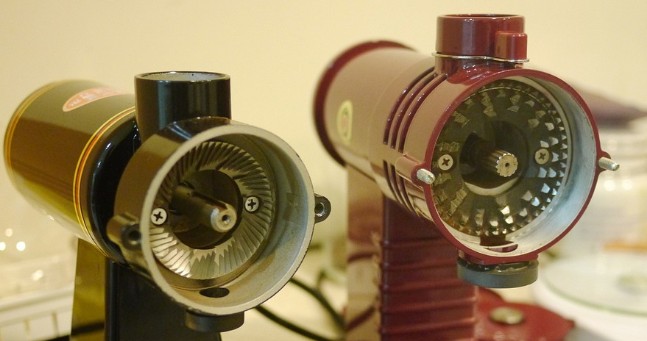Dara Zone district, Sidamo Red Cherry Plan Dutch trading company Trabocca BV
The Red Cherry Project (Operation Cherry Red), led by the Dutch trading company Trabocca BV and partly funded by the Dutch government, has been a small-scale farm quality improvement project since 2005. This project, which enhances coffee production and quality in remote areas of Ethiopia by providing producer expertise and related technology assistance, has been selected since 2005 for small coffee cooperatives at high elevations in Sidamo, Yegashev and Lim. Encourage and assist producers to improve the quality of coffee through testing (professional cup testers are also stationed in coffee producing areas) to ensure the quality of each batch by improving washing, semi-washing, solarization or other experimental treatments as far as they can. Before the harvest season, Trabocca invites selected smallholder organizations / producers to participate in the production of micro-batches of coffee (about 1500 to 3000 kg), carefully picking 100% ripe red coffee cherries by hand (hence the Red Cherry Project). Trabocca provides financial loan support, new hardware equipment and production processing knowledge and technology to assist farmers, promising to buy at a good price as long as the quality of the actual output meets the cup test standards in Addis Ababa in Ethiopia and Amsterdama Cup in the Netherlands. This year, the passing standard set by Trabocca is 88 points. The beans of the red cherry project are packed in plastic inner bags (GrainPro bags or vacuum box) immediately after the processing of the origin is completed, and then shipped to Djibouti for shipping. Strive for perfect quality through immediate monitoring, safe transportation and timely and appropriate handling.
Kaibedo is a small coffee cooperative in a small town in Dala, Sidamo Province. each small coffee farmer here has an average planting area of about 0.6 hectares and is composed of hundreds of coffee farmers. it is planted nearly 2000 meters above sea level, the climate varies greatly, and the soil is fertile, providing an excellent growing environment, and the raw bean itself exudes a strong aroma of raisins and fermented wine. The nearly yellowish-brown beans are actually small and slender, but the weight on the hands is very solid. After baking, we find that the bright berry aroma, or rich chocolate-like aftertaste, makes this bean have an eye-catching performance whether it is light baked or deep baked.
Flavor: berries, tropical fruits, fermented wine, jujube, tea, milk chocolate. Medium body, with a hint of spices and tea on the finish, is complex and long-lasting, tastes cleaner and more balanced after cooling.
English product name
Ethiopia OCR Sidamo-3 Kebado
Country
Ethiopia
Producing area
Dara Zone district, Sidamo
Producer
Local small farmers' cooperative in Kaibeidou
Grading
Grade 3
Treatment method
Insolation
Variety
Mixed native species (Heirloom)
Altitude
1800 to 2200 meters
The above information comes from the Taiwan coffee blog Organic Coffee blog.

Important Notice :
前街咖啡 FrontStreet Coffee has moved to new addredd:
FrontStreet Coffee Address: 315,Donghua East Road,GuangZhou
Tel:020 38364473
- Prev

Selection of coffee filter cup filter paper comparison of chemex hario filter paper and chemex filter paper
In order to let you have a more specific understanding of the Chemex filter paper, made the following comparison, the comparison method may not be scientific and accurate, but you can still have a general understanding of it from the side. The comparative samples selected are hario and Tiamo's 1-person tapered filter paper, which are the consumables used by most friends who play hand flushing. Mainly from the following
- Next

Small Fuji bean mill Rmur220 grinding speed solis 166900n Mazzer sj ghost tooth bean mill
Coffee bean English name Ethiopia OCR Sidamo-3 Kebado National Ethiopian production area Dala District (Dara Zone), Cedamo producer Cabedo Local small Farmers' Cooperative graded Grade 3 treatment method mixed with native species (Heirloom) Grinding evenness of Rmur220 from 1800 to 2200 meters above sea level needless to say, these are some of the ones I have used.
Related
- Beginners will see the "Coffee pull flower" guide!
- What is the difference between ice blog purified milk and ordinary milk coffee?
- Why is the Philippines the largest producer of crops in Liberia?
- For coffee extraction, should the fine powder be retained?
- How does extracted espresso fill pressed powder? How much strength does it take to press the powder?
- How to make jasmine cold extract coffee? Is the jasmine + latte good?
- Will this little toy really make the coffee taste better? How does Lily Drip affect coffee extraction?
- Will the action of slapping the filter cup also affect coffee extraction?
- What's the difference between powder-to-water ratio and powder-to-liquid ratio?
- What is the Ethiopian local species? What does it have to do with Heirloom native species?

